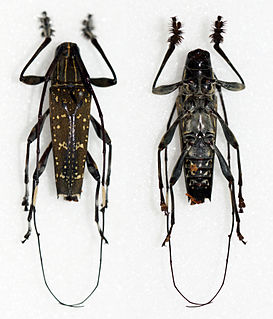Related Research Articles

The mosaic moray is a moray eel of the genus Enchelycore, found in south-eastern Australia and around the offshore islands off Northland on the North Island of New Zealand at depths down to 100 metres, in reef areas of broken rock. Their length is between 40 and 180 centimetres, making them the largest known member of their genus.

The hybrid elm cultivar Ulmus 'Den Haag' is a Dutch development derived from a chance crossing of the Siberian Elm cultivar Ulmus pumila 'Pinnato-ramosa' and the Belgian Elm Ulmus × hollandica 'Belgica'. S. G. A. Doorenbos (1891-1980), Director of Public Parks in The Hague, finding that seeds he had sown in 1936 from the Zuiderpark 'Pinnato-ramosa' had hybridized with the local 'Belgica', selected six for trials. The best was cloned and grafted on 'Belgica' rootstock as 'Den Haag'; it was planted first in that city, then released to nurseries elsewhere in the Netherlands. The other five were also planted in The Hague.

Pinguicula ramosa is a species of butterwort, a carnivorous plant, endemic to the mountains of Nikkō National Park in Japan. It belongs to the section micranthus and is closely related to Pinguicula variegata. It is unique in the genus for having a forked flower stalk.

The Siberian elm cultivar Ulmus pumila 'Pinnato-ramosa' was raised by Georg Dieck, as Ulmus pinnato-ramosa, at the National Arboretum, Zöschen, Germany, from seed collected for him circa 1890 in the Ili valley, Turkestan by the lawyer and amateur naturalist Vladislav E. Niedzwiecki while in exile there. Litvinov (1908) treated it as a variety of Siberian elm, U. pumilavar.arborea but this taxon was ultimately rejected by Green, who sank the tree as a cultivar: "in modern terms, it does not warrant recognition at this rank but is a variant of U. pumila maintained and known only in cultivation, and therefore best treated as a cultivar". Herbarium specimens confirm that trees in cultivation in the 20th century as U. pumilaL. var. arboreaLitv. were no different from 'Pinnato-ramosa'.

Asterogyne is a genus of flowering plant in the family Arecaceae native to Central America and northern South America, with three of the five known species endemic to Venezuela.

Aechmea ramosa is a plant species in the genus Aechmea. This species is endemic to eastern Brazil.

Orobanche ramosa is a species of broomrape known by the common names hemp broomrape and branched broomrape. It is native to Eurasia and North Africa, but it is known in many other places as an introduced species and sometimes a noxious weed.

Tragia ramosa is a species of flowering plant in the spurge family known by the common names branched noseburn and desert tragia.
Rigifilida is a clade of non-ciliate phagotrophic eukaryotes. It consists of two genera: Micronuclearia and Rigifila.

Colobotheini is a tribe of longhorn beetles of the subfamily Lamiinae.

Colobothea is a genus of longhorn beetles of the subfamily Lamiinae.
Colobothea decemmaculata is a species of beetle in the family Cerambycidae. It was described by Bates in 1865. It is known from Brazil and French Guiana.
Colobothea pimplaea is a species of beetle in the family Cerambycidae. It was described by Bates in 1865. It is known from Brazil, French Guiana, and Peru.
Colobothea discicollis is a species of beetle in the family Cerambycidae. It was described by Gahan in 1889. It is known from Brazil.
Colobothea picturata is a species of beetle in the family Cerambycidae. It was described by Monné in 1993. It is known from Venezuela.

Colobothea meleagrina is a species of beetle in the family Cerambycidae. It was described by Wilhelm Ferdinand Erichson in 1847. IT is known from Bolivia, Ecuador and Peru.
Colobothea chemsaki is a species of beetle in the family Cerambycidae. It was described by Giesbert in 1979. It is known from Costa Rica and Mexico.
Colobothea fasciatipennis is a species of beetle in the family Cerambycidae. It was described by Linsley in 1935. It is known from Honduras and Panama.
The elm cultivar Ulmus 'Turkestanica' was first described by Regel as U. turkestanica in Dieck, Hauptcat. Baumschul. Zöschen (1883) and in Gartenflora (1884). Regel himself stressed that "U. turkestanica was only a preliminary name given by me; I regard this as a form of U. suberosa" [:U. minor ]. Litvinov considered U. turkestanicaRegel a variety of his U. densa, adding that its fruits were "like those of U. foliaceaGilibert" [:U. minor].

Syllis ramosa is a species of polychaete worm in the family Syllidae. It is found in the deep sea where it lives within the tissues of a sponge. It was the first branching polychaete worm to be discovered, with each worm having a single head and multiple anuses.
References
- ↑ BioLib.cz - Colobothea ramosa. Retrieved on 8 September 2014.